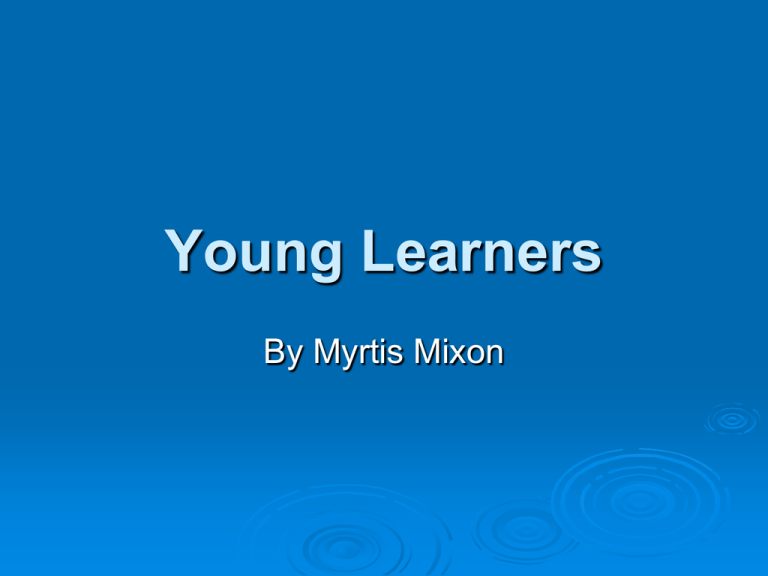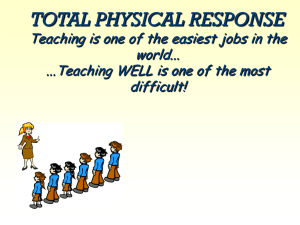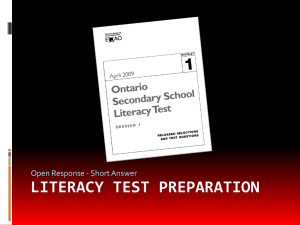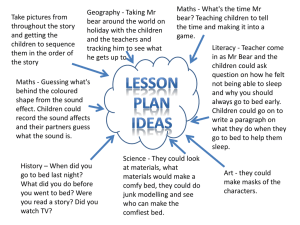Young Learners - riomediagroup
advertisement

Young Learners By Myrtis Mixon INTRODUCTIONS Do you know each other? How many of you are teachers? Who am I? PARDON ME WITH I RESPECT: am going to treat you like students: WHY? YOU LEARN MORE BY DOING! Warm Up Count off Form groups Telling a story with objects, toys or pictures TOYS TODAY Each group has a group of toys/objects Create a story including all your toys. Write it down or be prepared to tell it verbally. Each person must say something. You will show the toys when you tell your story to the others. Warm up? Or is it a major activity? What do you learn from this? Skills? Listen, speak, read, write? Also… Learning Styles Verbal (speak, listen, read, write) Auditory Tactile (listen, sing, rhythm & melody) (drawing, visualizing, touching) Kinesthetic (move, hands-on, role play, act Useful? Can you? Could you? Would you? Use this storytelling technique? Talk in your group. Ready Are you ready for more hard work? How to write an acrostic Choose any word: your name, or anything you want to describe, like the sun poem. Choose any word: Use the letters in the topic word to begin each line. All lines of the poem must relate to or describe the topic word. Using a name I want to be… Silent when others are talking Absolutely active in my life Love is what I hope for all Always looking to help Magnetic in my dealing with others. Story Theater? What is this? Most fun/learning-packed activity of all! Use almost any story. Folktales are great. Recipe 1. Each group has a section of the story. 2. Prepare your part of the story; use dialog, don’t just read. Don’t tell; show it. Adapt description into dialog. Choose any props on hand. 3. Line up to tell the story. TUG OF WAR Tortoise The hippo (hippopotamus) The elephant Tell it to students? Or get them to “present it”? Types of Questions? About Tug of War: look at handout. Knowledge Comprehension Application Analysis Synthesis Evaluation Learning Styles Again In your group, Talk about what kind of learning styles does this activity address? Verbal Auditory Tactile Kinesthetic Your storytelling texts Can you adapt your books to story theater? How? Sentence Structure Practice Use small books Use BIG BOOKS Error Correction At this age, use very little verbal correction. Promote Hold fluency first. back or some will turn silent. Example: German sentence Songs Which ones do you use? Make up simple songs with the stories in your book. e.g. I will go; you will go; we will go today. TPR songs: Look to the left, etc. Hokey Pokey is many skills: singing, movement, listening, and can be reading too. ORAL SKILLS Speaking and Listening Chunking As in poetry: Oh, he walked along the river On his four fur feet, His four fur feet, His four fur feet. He walked along the river On his four fur feet And heard the boats go toot O. TPR Total Physical Response More than commands Using TPR Use TPR to teach prepositions Combine with realia for prepositions..toy Use TPR with mime… and let them guess Simple (I walk across… Sequences: getting ready to leave; Baking a cake, setting a table Cleaning house Use short dramas that you direct TPR Frogs jump -> worms wiggle -> rabbits hop -> Snakes slide -> Mice creep -> Puppies bounce -> Lions stalk but… caterpillars hump bugs jiggle Horses clop Sea gulls glide Deer Leap Kittens pounce I walk (Evelyn Beyer) Do the Hokey Pokey CHANTS Brown Bear, Brown Bear by Bill Martin, Jr. Brown Bear, Brown Bear, what do you see? I see a red bird looking at me. Red bird, red bird looking at me I see a Yellow Duck, Blue Horse Green Frog Purple Cat White Dog Black sheep Gold Fish Teacher Children We see brown bear, yellow duck, blue horse etc. Looking at us. Pairs: HOW COULD YOU CHANGE IT & RE-USE IT? Let’s wait til structure drills Other Chanting Books LOOK ONLINE Polar Bear, Polar Bear, What do you hear? (Lion roaring) Hippo snorting Flamingo fluting Zebra braying Boa Constrictor hissing Elephant trumpeting Leopards snarling Peacocks yelping etc. until the zoo keeper whistles Zoo keeper hear children hears lions roaring, hippo snorting, flamingos fluting etc. Children can be creative and in writing, make up their own animals or their sounds to hear. Use all the senses. Speaking WE started speaking already, didn’t we? Creating stories using: everyday objects (teacher in Albania) toys Pictures These activities can include writing. Combinations Skills are usually not isolated Many speaking activities are also listening activities Many reading activities are also speaking, listening and writing activities. Skills don’t exist in isolation. Different activities usually stress one but include several Reading Skills Reading Skills Choral Reading Group Reading How to check for comprehension? Of course, these are combined skills activities USING STORIES Hundreds of ways to use a story: Teacher/student Choral telling OR retelling reading Story boarding (chart the storyline) Role Play TPR Choose to change the ending Little Books In your group, work with the little book you have… how can you use this book to teach Listening? Speaking? Reading? Writing? Test your listening Truth and Story or The Stonecutter or The Lion and the Mouse (Pair up) Take turns retelling it to your partner. Improve Intonation and Stress Patterns One, Two, Buckle my shoe. Three, Four, shut the door. Five, Six, pick up sticks. Seven, Eight, lay them straight. Nine, Ten, a good fat hen. Humpty Dumpty Sat on a Wall Humpty Dumpty had a great fall; All the King’s horses and all the King’s Men Could not put Humpty together again. Shadowing Use Shadowing with rhymes. Shadowing is repeating under your breath or in a whisper After each of my phrases, repeat under your breath, or whisper - Know that you will have to retell the story Some ideas? Reading? Writing? Listening? Speaking? Combining Skills Use Stone Cutter Write questions for each paragraph of the story Role Play (not a summary this time!) Brown Bear, Brown Bear OTHERS: Polar Bear, Baby Bear, Chicka Chicka 123. By Bill Martin Jr. & Eric Carle The Very Hungry Caterpillar By Eric Carle HOW COULD YOU USE THE SMALL BOOK? WHAT IF YOU HAD LOTS OF SMALL BOOKS SHARE English Language Forum Young Learners Issues (search online) Vol. 44, #2, 2006: “First Road to Learning” By Myrtis Mixon and Philomena Temu That’s All Folks! Myrtis101@mac.com Goal Setting What is your idea of what you will accomplish today? Write down two goals My Goals for You Are At least ten new ideas or ‘re-treads’ Ten pieces of usable materials As interactively as possible not a lazy day Your Homework Find your homework. After count/off, form into groups of 3s. Share your ideas about teaching different skills with your trio. Anyone Hand want to share with all of us? in the Homework to me, name not necessary Listening The Hardest, The most NEGLECTED Skill Tug of War I (teacher) tell it) Now in a pair, you choose strategies to use with this story. Include two strategies for each of the four skills. SHARE… Story Cards Use: Hard Paper Index Cards Use the story cards for: Fables Short Biographies Student created cards FEEDBACK 1. Look at the two main handouts. 2. List some of the activities that you can use or how you will change them. 3. What area in Teaching Young Learners do you need to learn about the most? 4. What else can you say about our time together? Choral Reading Use with rhymes Does not have to be rhythmic Use with stories that they have in front of them (we will do that with a story) doucey101@hotmail.com www.riomediagroup.com/blanche35now








